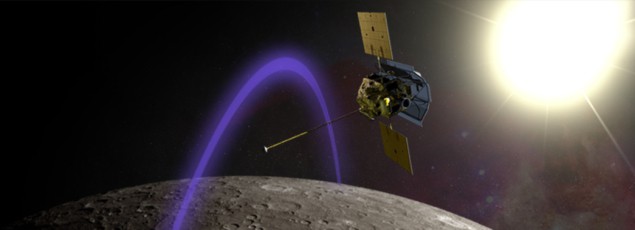
The first spacecraft to orbit Mercury began circling the solar system’s smallest and least-understood planet early this morning, in what mission scientists hailed as the “historic” conclusion to a six-and-a-half year, 7.9 bn kilometre journey.
At 12.45 a.m. GMT on Friday 18 March the main thrusters on NASA’s MESSENGER spacecraft began firing, slowing it down by 0.862 km/s so that it could be “captured” by Mercury, which has an escape velocity of 4.25 km/s.
After the 15-minute “burn” finished and the spacecraft repositioned itself for transmitting signals back to Earth, mission operators at the Johns Hopkins University Applied Physics Lab (APL) spent another anxious 10 minutes analysing the anticipated radiometric signals confirming nominal “burn shutdown” before declaring that MESSENGER had been successfully inserted into orbit around Mercury.
By 1.45 a.m. GMT the craft had rotated back to the Earth and started transmitting data.
“Achieving Mercury orbit was by far the biggest milestone since MESSENGER was launched more than six and a half years ago,” says MESSENGER project manager Peter Bedini from APL. “This accomplishment is the fruit of a tremendous amount of labour on the part of the navigation, guidance and control, and mission operations teams, who shepherded the spacecraft through its journey.”
The fun starts here
At 6:47 a.m. MESSENGER began its first full orbit around Mercury, tracing out an elliptical path that brings it within 200 km of the planet’s scorched and cratered surface before swooping out to 15,193 km, where the reflected heat from the surface is less intense. The craft’s instruments are due to be activated on 23 March, with the primary “science phase” of the mission beginning on 4 April. Over the next year, the craft will complete one such revolution every 12 Earth-hours, racking up 730 laps before the mission’s scheduled end.
During this time, instruments on the half-tonne, $446m craft will collect unprecedented amounts of data about Mercury’s surface features and composition, as well as its magnetic field and tenuous atmosphere, or exosphere. According to MESSENGER principal investigator Sean Solomon from the Carnegie Institution for Science in Washington, DC, these data will yield new information on some of Mercury’s biggest mysteries – including the intriguing possibility that our solar system’s innermost planet, where surface temperatures can exceed 700 K, may harbour small amounts of water ice in its polar regions.
Infrequent visitors
MESSENGER is the first spacecraft to visit Mercury since the mid-1970s, when the Mariner 10 probe flew past three times. That mission notched up several intriguing discoveries – including Mercury’s magnetic field and exosphere – but it mapped only 45% of the planet’s surface and left many questions unanswered.
MESSENGER had already added to this body of knowledge before today’s rendezvous, thanks to its complex trajectory. To reach the correct velocity and position for entering Mercury orbit, the spacecraft flew past the planet three times in 2008 and 2009, using the planet’s gravity to tweak its path each time. During these fly-bys, MESSENGER’s camera imaged most of what Mariner 10 missed, while spectrometers collected data on Mercury’s composition and a magnetometer sketched out the geometry of the planetary magnetic field.
Despite these early successes, for many scientists this morning marked the real beginning of MESSENGER’s mission. “The three successful fly-bys of MESSENGER past Mercury have already rewritten the textbooks about the Sun’s nearest neighbour,” said Daniel Baker, a co-investigator on the mission, speaking ahead of the orbit insertion. “But we think there is so much more to learn – we’ve probably just scratched the surface.”
Solving Mercury’s mysteries
One of the biggest remaining puzzles is Mercury’s magnetic field, which has been a “great mystery” ever since Mariner 10 discovered it, Solomon told physicsworld.com. Mercury’s intrinsic field is weak, with a dipole strength almost 1000 times less than Earth’s. However, since larger planets like Mars and Venus have no intrinsic dipolar field at all, the existence of even a weak field on Mercury is surprising.
Another related question is Mercury’s extraordinarily high density, which at 5.3 g/cm3 is the biggest of any planet in the solar system, after gravitational compression is factored out. To achieve such a high density, Mercury’s heavy, metal-rich core must account for 60% of its mass, compared with 30% for the cores of Earth, Mars and Venus. The presence of a magnetic field also suggests that this core is at least partially molten. However, the structure and dynamics of Mercury’s core are poorly understood, and there are competing theories for why it is so large relative to the rest of the planet.
MESSENGER’s suite of seven scientific instruments – which includes an altimeter as well as the camera, magnetometer and four spectrometers – should begin to answer these questions on 4 April, after the spacecraft has passed a series of checks to determine that it is operating well in Mercury’s harsh thermal environment.
Project scientists are used to being patient. When MESSENGER launched in 2004, “this milestone seemed like it was a long, long way away,” says mission co-investigator Bill McClintock of the University of Colorado’s Laboratory for Atmospheric and Space Physics. “But here we are at last, poised to help solve some of the many tantalizing mysteries about Mercury.”



